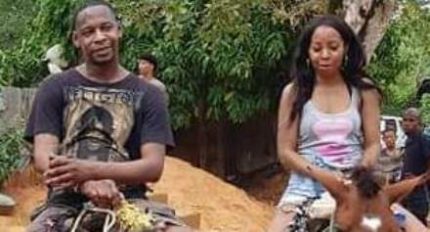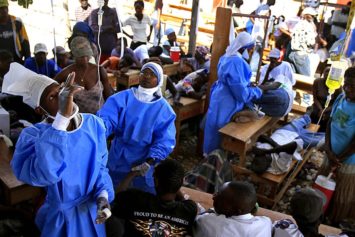
To take in the entire thing requires traveling between the Studio Museum in Harlem and El Museo del Barrio, both in Manhattan, and across the East River to the Queens Museum of Art in Flushing. If you’re short on time or patience, any single segment is dense and vivid enough to give you the flavor of the whole. But if you can see all three, absolutely do.
Each tells a hugely complex story from a different thematic angle — collectively, a telling that has been long in the planning, and is long overdue. (Caribbean material has thus far not shared in the aura of glamour that has gathered around Latin American art.) While not strictly speaking a masterpiece show, its like won’t be attempted again on this scale and in this depth for some time.
The story is woven as much from questions as from answers, from intangibles as from facts. Is the Caribbean a place? If so, what are its boundaries? Are Florida and Colombia as much part of it as Cuba? Is there a Caribbean culture, and how do you define it, given the mix of African, Asian, European and indigenous elements that blend, in quite different proportions, on some three dozen islands in the region?
And even if the Caribbean is defined, loosely and poetically, as a state of mind, a mood, how do you capture that in an exhibition, when so much of that mood has, traditionally, been expressed more in music and performance than in static visual forms?
A team of nine scholars and curators — Gerald Alexis, Rocio Aranda-Alvarado, Deborah Cullen, Hitomi Iwasaki, Naima J. Keith, Yolanda Wood Pujols, Lowery Stokes Sims and Edward J. Sullivan, led by Elvis Fuentes, curator for special projects at El Museo del Barrio — has pondered these matters, produced a book that is sure to become a staple reference, and shaped an exhibition so crowded with unexpected sights as to appear at times practically shapeless, absorptive rather than expository.
It says a lot that although few interpretive labels accompany the more than 500 objects assembled, many of which cry out for elucidation, the show still makes sense.
Even as you puzzle over the details — What’s this? Why is it here? — you get the big picture.
Historically the picture starts at the Studio Museum, late in the 18th century. By this time indigenous peoples throughout the Caribbean had been suppressed; masses of captive Africans had been imported; a white population, largely mercantile, had settled in. From a European perspective the region had become the subject of myths — pleasurable, fearful and often centered on race.
For decades émigré painters to the Caribbean, many working for colonial estate holders, had depicted life there as a sequence of serene multicultural picnics set in parklike tropical gardens. All imagined idylls were decisively shattered, however, in 1791, with the slave rebellion in Haiti that led to that country’s independence from France.
The uprising coincided with the French Revolution, when the ideal of the brotherhood of man was ascendant in Europe. In that spirit a leader of the Haitian struggle, Jean-Baptiste Belley, a former slave born in Senegal, was elected to the National Convention in Paris. There’s a remarkable chalk drawing of him in the show, by Anne-Louis Girodet de Roussy-Trioson, a student of Jacques-Louis David.
Dated 1797, it depicts him wearing a stylish European waistcoat and posed like a classical Apollo. At the same time his fastidiously detailed Negroid features and provocatively sexualized body make him look less a Romantic political hero than a well-dressed New World wild man.
Racial difference, as an alien and threatening reality, formed the fundamental view of the Caribbean — as it did, and still does, of Africa — in the eyes of much of the rest of the world.
A second gallery at the Studio Museum, labeled “Land of the Outlaw,” is filled with European images of the Antilles as a nightmare of ravenous beasts, hostile natives and monstrous phantoms associated with indigenous religions.
But monstrous is in the eye of the image maker. Race, or the perception of it, can function as a social unifier; it can also be approached as an unstable and alterable condition. The exhibition includes an amazing sculpture, pieced together almost entirely from matchsticks by the contemporary Jamaican artist Dudley Irons, of Marcus Garvey’s fabled Black Star Liner, conceived as a trans-Atlantic slave ship in reverse, bringing former slaves back to Africa from America.
And there’s a knockout collage portrait, finished last year, by Ebony G. Patterson, who divides her time between Jamaica and Lexington, Ky., of a young black man with a masklike white face. The image refers to the often-against-the-law world of Jamaican dance-hall culture, and specifically to its fashion for skin-bleaching as a cosmetic means of both attracting attention and — playing around with the idea, dating back to slavery and forward to Michael Jackson — determining social status based on skin color.
Ms. Patterson’s glitter-encrusted portrait, part monument, part mug shot, suggests the double-edged potential of radical identity transformation. It pays off with immediate rewards, but you may not like where it takes you, and there may be no going back. Applied to other, broader subjects, this is also the theme of the section of the show installed at El Museo del Barrio.
In the first gallery we find 18th- and 19th-century paintings, by European artists and Caribbean ones trained in European styles, of the colonized islands as an earthly Eden. Yet there is subtle evidence that we’re seeing a labor-intensive profit-making paradise, with sugar and tobacco as early export commodities, and oil coming later.
And it becomes increasingly clear, as idealized views of Caribbean life recede in art, that the producers of these commodities not only derived little benefit from them but also incurred direct harm. Working conditions were harsh; the drive for productivity was ruining land. In Albert Huie’s 1955 painting “Crop Time” black smoke pouring from a processing-plant chimney darkens the Jamaican sky.
In recent decades offshore oil drilling, which can pollute water and contaminate beaches, has endangered the one major cash-generating resource Caribbean residents can claim as their own: tourism, with its vision of island life as state of natural purity and innocence. That vision has been in wide circulation throughout the West for centuries.
We see it in an 1856 painting by Camille Pissarro of St. Thomas, where he was born; in exuberant prints Paul Gauguin made after visiting Martinique; in art by sojourning European Surrealists; and in work by Caribbean artists who chose not to join the international Modernist mainstream but rather to seek what felt like a truer foundation in their native or national cultures.
But there is no pure state, no unblemished source, no unburdened goal, as the show repeatedly emphasizes. That’s the message in William Blake’s dolorous poem “The Little Black Boy” from “Songs of Innocence and of Experience,” seen in a hand-colored 1789 etching. And it’s the reality implied in a 1990s sculpture called “All-Stars” by the Jamaican-born artist Nari Ward, which consists of a baseball bat — contemporary Caribbean emblem of heroic aspiration — wrapped in medical tape, bristling with nails and coated with raw sugar, on which bits of cotton are stuck like fungal growths.
Reality itself — social, economic, spiritual — is in a constant state of flux, and this is the theme of the portion of the show at the Queens Museum of Art, where the dominating images are of change and interchange, embodied in the movement of water. In painting, photographs and videos we see it sluicing among islands, washing against shorelines, penetrating interiors, carrying trading ships and battleships, fishing boats and ferries.
Its flow is even echoed in the flow of air currents that carry aloft a fabulously absurdist wooden airplane designed and built by Charles Juhasz-Alvarado, an artist based in Puerto Rico of irrepressible imagination.
And, of course, where there are boats and planes, there are people coming and going. For centuries the Caribbean has received, and sent out, streams of them: Africans, Americans, Arabs, Chinese, Europeans, Sephardic Jews, South Asians, all bringing art, attitudes, cuisines, languages and religions with them. They’re all represented in the large second part of the Queens installation, built around the theme of carnival. And here the dizzying array of visual impressions characteristic of the show overall becomes almost overwhelming.
Paintings are ganged together on walls. Figural sculptures teeter across the floor. Masks pop up in 19th-century prints, in paintings by Ada Balcacer, Minnie Evans and René Portocarrero; in collages by K. Khalfani Ra; and in sculptures by Peter Minshall. The great Everald Brown supplies unearthly musical instruments; there are rituals, religious and secular, and festival dances everywhere.
If you’ve come this far — or even if you’ve seen only one of the show’s three segments — you will have encountered histories you never knew and artists you have rarely, if ever, heard of.
Isn’t telling us what we don’t know part of the job of museums? In this case three small institutions with limited staff and resources have cast their nets wide and dug deep, and come up with something big.
Source: Holland Cotter, NY Times


